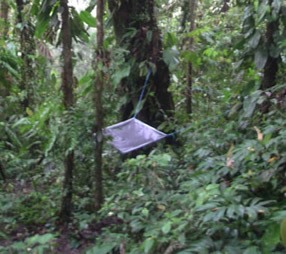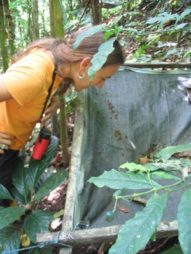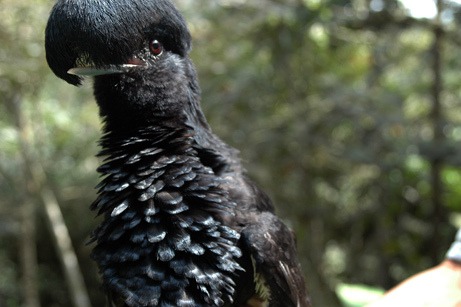Our Efforts
Top-level scientific research is the mainstay of our efforts in Ecuador. The breadth, depth, and quality of our science is what sets us apart from other conservation organizations. We have initiated and implemented cutting-edge research projects with conservation implications throughout Ecuador, with a focus on the Chocó rainforests in the northwestern region of the country.
The Chocó Biogeographical Region, which spans 100,000 km² of humid forest in western Colombia and northwestern Ecuador, is one of the most biologically diverse areas in the world. It is a world-recognized Hotspot, and surveys have revealed exceptional levels of diversity and endemism in plants (especially palms), insects, and vertebrates (especially birds).
The Ecuadorian Chocó is a global conservation priority. In 1996, less than four percent of Ecuador’s primary forests remained and deforestation has continued at a steady pace since that survey was carried out nearly a decade ago. The local populace is deeply impoverished and has few alternatives to ecologically harmful practices such as slash-and-burn agriculture, timber extraction, and hunting. Without active conservation training and education initiatives, remaining rainforest will almost certainly be lost, with a great loss to biodiversity and to the well-being of the local populace.
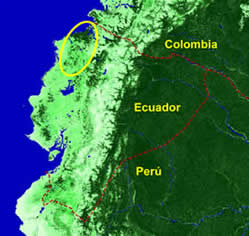
Map of the Ecuadorian Chocó
CTR is working to provide the concerted and effective conservation action that the Chocó needs. Our project combines top-level, multidisciplinary scientific research with on-the-ground training, capacity building, and education to achieve lasting conservation results. Our approach on both the social and scientific levels is based on the inclusion and involvement of local Ecuadorians. Below, we provide a brief overview of our primary research projects in the Chocó. For more information on our research and training program and on volunteer opportunities, contact CTR Latin America Director Dr. Jordan Karubian.
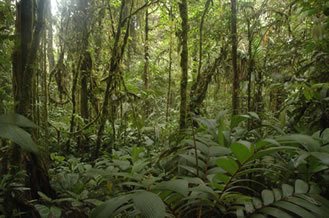
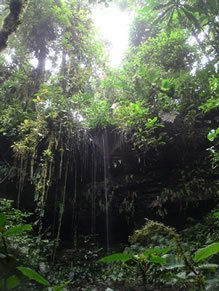
Left: Primary Chocó rainforest, one of the most diverse ecosystems on the planet
Right: A small waterfall in primary Chocó rainforest
Long-wattled Umbrellabirds
Long-wattled Umbrellabirds (Cephalopterus penduliger) are large birds endemic to the Chocó rainforests, meaning that they are found nowhere else on earth. As is the case with many Chocó endemics, they are at risk. Long-wattled Umbrellabirds are sensitive to the human activity and deforestation that has been ravaging the Chocó and have suffered a population decrease of more than 20% in the past ten years. Current population size is below 10,000 individuals, and the species is in danger of extinction.
The Long-wattled Umbrellabird is a spectacular bird with a truly outlandish appearance. Males have highly evolved crests, wattles, plumage, displays, and song, and are nearly double the size of females. During the mating season, males congregate every morning in lek sites, where they display to females. In this unusual mating system, females visit the lek sites only to copulate, and take care of all other aspects of rearing young by themselves. Long-wattled Umbrellabirds eat fruit and are important dispersers of large seeds of primary forest trees. As such, they play a critical ecological role in the maintenance of primary forest and in the regeneration of disturbed habitat.
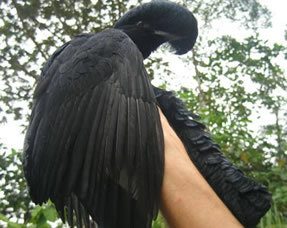
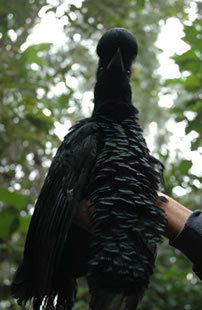
Male Long-wattled Umbrellabird
Since 2002, CTR has been carrying out intensive research on the Long-wattled Umbrellabird. Our methods include trapping the birds in mist nets that we position in the forest canopy, taking morphological measurements, applying color bands for subsequent identification, and attaching a small radio to the tail before releasing the bird to the wild. Radio-equipped birds are then tracked through the forests and data on habitat use, social behavior, and foraging activity is recorded. These data are used with GPS coordinates to map habitat requirements and movement patterns, and to measure seed dispersal from primary to secondary forests. The data we gather has important consequences for conservation of this unique species, and the Choco habitat upon which it depends.
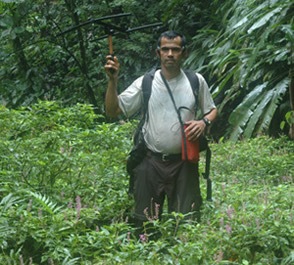
Jorge Olivo using radio telemetry equipment to track the
movements of a radio-tagged Long-wattled Umbrellabird
Banded Ground-cuckoo
Despite its large size and striking appearance, the Banded Ground-cuckoo (Neomorphus radiolosus) is one of the least-known birds in Ecuador. In the recently published Guide to the Birds of Ecuador, for example, the species is only reported in four localities in Ecuador. The Banded Ground-cuckoo is considered an endangered species within Ecuador, and either vulnerable to extinction or in danger of extinction throughout its range. As with the Long-wattled Umbrellabird, the precarious state of the Banded Ground-cuckoo is attributed to the widespread loss of primary Chocó forests. Before our research, there have been no detailed studies on the Banded Ground-cuckoo or any of its congeners, and its basic biology is almost completely unknown.
We have initiated the first long term study of the Banded Ground-cuckoo in Chocó rainforest, including radio tracking a single adult for nearly a year. This adult led us to the first confirmed nest for the species, which was active in March and April 2005 and was attended by two adults that contributed equally to incubation, brooding, and provisioning of a single nestling. The nest was located in primary rainforest. When not nesting the radio-equipped adult occupied a home range of five square kilometers, with a marked preference for undisturbed habitat. The data we have gathered underscores the importance of primary rainforest habitat for conservation of the Banded Ground-cuckoo. Our findings, currently in review for publication, were presented at an international meeting in Ecuador by Luis Carrasco.
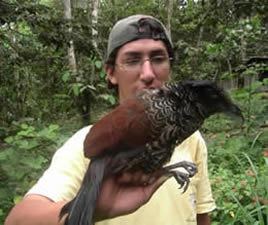
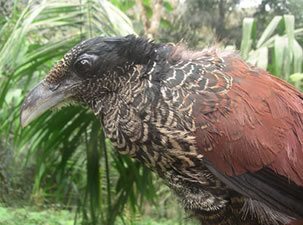
Left: Luis Carrasco holding a Banded Ground-cuckoo
Right: Banded Ground-cuckoo, one of the least
Purple-throated Fruitcrows
Like the Long-wattled Umbrellabird, the Purple-throated Fruitcrow (Querulus querulus) is a large, mostly black Cotinga. But that is where the similarities stop. Purple-throated Fruitcrows eat insects and form large, socially cohesive groups in which several individuals help raise the young. This provides a fascinating and instructive contrast with the fruit-eating, lek-breeding Long-wattled Umbrellabirds. We are carrying out a long-term study of the Purple-throated Fruitcrow that includes tracking radio-equipped individuals, mapping home ranges, and documenting social biology and foraging ecology. Our goal is to document the basic biology of this common, but little-known species and to contrast these findings with information on the Long-wattled Umbrellabird. Among other insights, this study will clarify our understanding of how differences in resource exploitation can result in very different patterns of social organization.
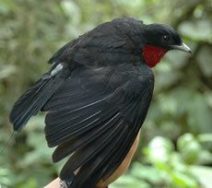
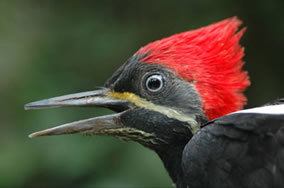
Left: Radio equipped Purplet-throated Fruitcrow, just before release to the wild
Right: Male Purple-throated Fruitcrow
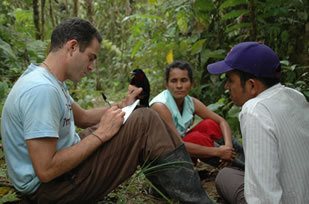
Purple-throated Fruitcrow with Jorge and Rosa Olivo
Seed Dispersal by Large Avian Frugivores
Seed dispersal by animals plays an important role in maintaining the structure of tropical rainforests and is also central to the process of regeneration of forests that have been cut. For example, up to 80% of tree species in tropical forests may rely on animals to disperse their seeds. However, next to nothing is known about this critically important ecological process in the Chocó. CTR has begun a long-term study of seed dispersal by birds in the Chocó, with the aim of documenting natural patterns of seed dispersal and their importance for the regeneration and maintenance of rainforests in the area.

By combining three pieces of information – what fruits the birds eat, how long it takes them to pass these seeds, and what their movement patterns are like during this window of time – we are able to calculate seed dispersal shadows for each of the species. Our study focuses on large avian seed dispersers such as toucans, parrots, guans, pigeons, and cotingas, as well as smaller, fruit-eating birds such as manakins and tanagers. This information provides novel insights on a basic ecological process while providing crucial information for locally relevant conservation decisions such as reforestation methodologies and land purchase strategies. Our long-term goal is to combine these data with information on seed dispersal by bats, other mammals, and insects to obtain a comprehensive understanding of this phenomenon and better direct conservation efforts in the zone.
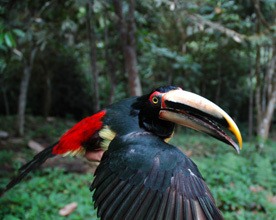
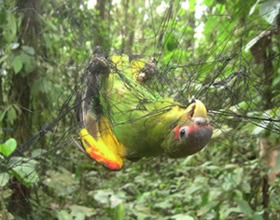
Avian Sampling
Chocó rainforests house an outstanding diversity of birds, many of which are found nowhere else on earth. We have established a long-term study of avian diversity in the Chocó using both point counts and mist netting methods to document patterns of diversity in relation to habitat quality. This study, begun in 2003, combines point counts (in which birds are identified by song from pre-established monitoring stations) with mist nets (in which birds are captured in stationary nets, banded and measured, and released unharmed).
Our sampling regime allows us to compare avian diversity and abundance in primary, secondary, and selectively logged forests. We have captured over 6,000 individuals of 141 species, 11 of which had not previously been recorded in the zone, and have conducted over 1,000 hours of point counts. In addition to providing data on diversity and abundance in relation to habitat type and habitat preferences of individual species, we are gathering novel information in morphology, demography, breeding biology, hummingbird pollination biology, and natural history. This project has served as an honor’s thesis or training opportunity to many Ecuadorian and international students, including Luis Carrasco, Andrew Cook, and Erin Wianko. We plan to continue this sampling for the long term.

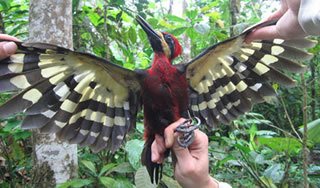
Hummingbird Pollination Biology
We have trapped thousands of individual hummingbirds of 14 species in mist nets as part of the avian sampling work described above. Capitalizing on this high capture rate, we have begun a study of hummingbird pollination biology based on collecting pollen from captured birds’ bills. Ms. Maria Fernanda Salazar and Ms. Veronica Salazar are jointly using this collection of pollen samples to leverage the first intensive study of hummingbird pollination biology in the Chocó. Each month, these honor’s thesis students at Universidad Central in Quito, Ecuador, analyze pollen grains collected in the field using a microscope in the laboratory of Dr. Carlos Ceron. The students also take regular trips to the study site to collect pollen samples from flowering plants to assist with identification. This work will further our understanding of this basic ecological process while laying the foundation for some fascinating future honor’s thesis projects.
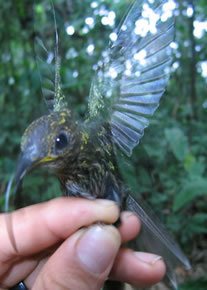
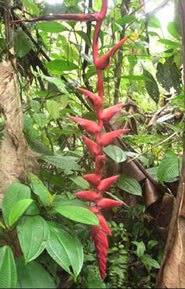
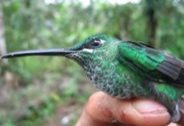
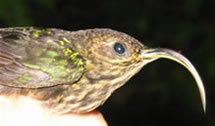
CTR is studying how differences in foraging ecology result in different bill shapes in hummingbirds
Phenology
Since 2003, we have been gathering the first systematic data on timing and extent of flower and fruit production (plant phenology) in relation to habitat type for the Chocó. In 2003, Ms. Rocio Monobanda collected data along 9,000 meters of transect which pass through primary, secondary, and selectively logged forest for one full year. Additionally, Ms. Monobanda collected detailed data every three weeks on fourteen species of tree known to be important sources of fruit for avian frugivores. This work has served as an honor’s thesis project for Ms. Monobanda at Universidad Central. Since 2004, phenology sampling has been conducted by Mr. Domingo Cabrera, a man from a local community. Currently, we are taking systematic data on twenty species of tree. As with the avian sampling, our goal is to continue gathering long-term data on phenology.
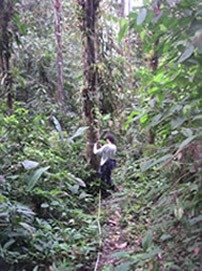
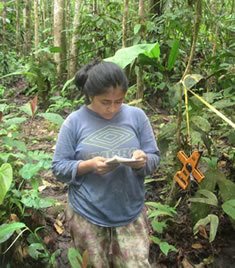
Reforestation and Natural Regeneration
Reforestation and establishing ecological corridors are top conservation priorities in the Ecuadorian Chocó. Yet the question of how to best regrow a rainforest remains unanswered. From a scientific perspective, the majority of reforestation efforts have proceeded with little attention to evaluation or the general applicability of findings. Without comparative study, the product of these projects is unpredictable and, at worst, may impede the natural progression of forest regeneration rather than assisting it. To construct functional habitat quickly enough to connect what is left before it is gone, reforestation must be designed not only to augment plant communities, but also to assist forest succession by counteracting the ecological factors that limit natural regeneration.
Ms. Amy Rogers, a Ph.D. candidate at UCLA, has designed an extensive, field-based study to address these challenges. Our goal is to identify optimal assisted natural regeneration techniques for the Chocó. Specifically, we are working to determine the ecological factors that pose the greatest obstacles to the transition from secondary to primary forest—information that will indicate the counteractive measures necessary to accelerate primary forest establishment in the Chocó. By ensuring that reforestation practices synergistically complement the natural limits of forest regeneration, Ms. Rogers is providing the area’s first systematically evaluated framework for corridor and buffer zone management objectives.
